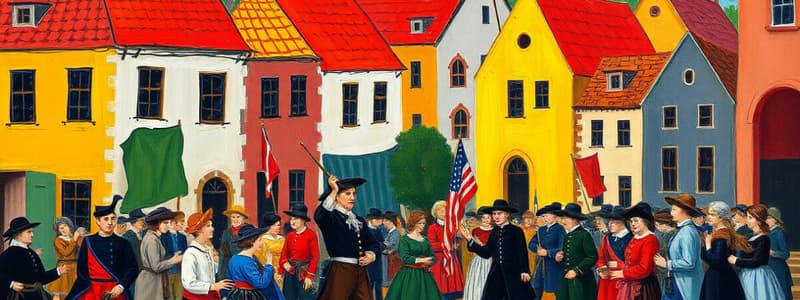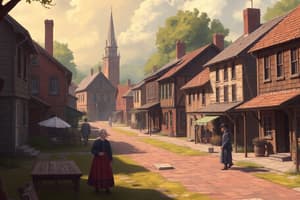Podcast
Questions and Answers
What type of roofs are the homes in the town primarily made from?
What type of roofs are the homes in the town primarily made from?
- Wood with thatch roofs (correct)
- Metal roofs
- Clay tile roofs
- Shingle roofs
The town is noted for its quiet atmosphere.
The town is noted for its quiet atmosphere.
False (B)
What is the primary source of lighting mentioned for the town?
What is the primary source of lighting mentioned for the town?
Torches
The streets of the town are primarily made of _____.
The streets of the town are primarily made of _____.
Match the following details with their descriptions:
Match the following details with their descriptions:
What is one of the rights established by the English Bill of Rights of 1689?
What is one of the rights established by the English Bill of Rights of 1689?
The Magna Carta established that the monarch has absolute power over the law.
The Magna Carta established that the monarch has absolute power over the law.
What was the significance of the Magna Carta in terms of political rights?
What was the significance of the Magna Carta in terms of political rights?
The right to petition the King is an example of a right included in the __________.
The right to petition the King is an example of a right included in the __________.
Match the following colonies with their expectations regarding political rights:
Match the following colonies with their expectations regarding political rights:
Which of the following crimes could lead to the death penalty in Colonial America?
Which of the following crimes could lead to the death penalty in Colonial America?
In Colonial America, branding was used as a punishment for serious crimes.
In Colonial America, branding was used as a punishment for serious crimes.
What significant legal event occurred in 1691 in Colonial America?
What significant legal event occurred in 1691 in Colonial America?
The practice of keeping people in __________ was punishable for crimes like theft and forgery in New England.
The practice of keeping people in __________ was punishable for crimes like theft and forgery in New England.
Match the following punishments with the corresponding crimes:
Match the following punishments with the corresponding crimes:
Which of the following characteristics is primarily associated with the upper class in Colonial America?
Which of the following characteristics is primarily associated with the upper class in Colonial America?
Lower class individuals in Colonial America often had the right to vote.
Lower class individuals in Colonial America often had the right to vote.
Match the following social classes with their characteristics:
Match the following social classes with their characteristics:
What happened to some individuals in the context of rebellion?
What happened to some individuals in the context of rebellion?
All rebels were successful in their efforts.
All rebels were successful in their efforts.
What is one consequence faced by individuals who rebelled?
What is one consequence faced by individuals who rebelled?
Some rebels ______ away to avoid consequences.
Some rebels ______ away to avoid consequences.
Match the following actions with their outcomes:
Match the following actions with their outcomes:
What was a primary crop that fueled the expansion of slavery in the Southern Colonies?
What was a primary crop that fueled the expansion of slavery in the Southern Colonies?
The conditions on the Middle Passage were generally safe and comfortable for enslaved Africans.
The conditions on the Middle Passage were generally safe and comfortable for enslaved Africans.
From which region did the majority of enslaved Africans come?
From which region did the majority of enslaved Africans come?
Enslaved people were at the ______ of the social hierarchy during Colonial times.
Enslaved people were at the ______ of the social hierarchy during Colonial times.
Match the following specialized roles with their functions:
Match the following specialized roles with their functions:
What percentage of the population lived in the city during Colonial America?
What percentage of the population lived in the city during Colonial America?
Taverns were primarily known for selling farm products.
Taverns were primarily known for selling farm products.
Name one item that ships brought from England to the city.
Name one item that ships brought from England to the city.
People could buy fresh eggs, milk, and cheese at the _________.
People could buy fresh eggs, milk, and cheese at the _________.
Which of the following was NOT a type of shop mentioned in the city?
Which of the following was NOT a type of shop mentioned in the city?
Match the following shops with their primary function:
Match the following shops with their primary function:
The waterfront was a significant area for buying food.
The waterfront was a significant area for buying food.
What type of products could be bought in the Market Place?
What type of products could be bought in the Market Place?
Flashcards are hidden until you start studying
Study Notes
Town Observations
- The town was noisy.
- Shelly Place was a place in the town.
- Hot church bells were a detail mentioned.
- Carts and horses were present.
- Mosquitos and flies were present.
- Rotten garbage was an issue.
- Cobblestone streets were present.
Homes
- Homes were close together.
- Homes were made of wood with thatched roofs.
- The windows were small, and glass was expensive.
Lighting
- Torches were the primary lighting method.
- Betty Lamps were another source of light.
- Grease and/or candies were likely used for making candles or lamps.
Other Observations
- A bucket system was used to fight fires.
- The water source was from a river or pond.
- The water source had an effect on the entire town.
Colonial America Political Rights
- Magna Carta established that the King's power was limited; the king was not above the law.
- Lawmakers and representatives across England were present.
- The English Bill of Rights (1689) stated that imposing taxes was the right of the people.
- Elected representatives were present.
- The right to petition the king (demands/requests) was given to the people.
- The right to a trial by jury was established.
Colonial America Crime and Punishment
- Each colony had its own laws that defined crimes and how they were punished.
- The death penalty was used for murder, treason, and piracy.
- "Denying the true God" was a crime in New England.
- Jail was punishment for theft, forgery, highway robbery, and other crimes.
- Whipping or branding were punishments.
- Drunkenness, breaking the Sabbath, and spending time in the stocks (wooden frame) were other punishments.
- New England Puritans believed in stricter rules and required Sunday worship.
- Blue Laws were strict laws that were put in place to watch for Satan.
- The Salem Witch Trials in 1691 resulted in false accusations of witchcraft against 25 women. Young girls made the accusations.
Colonial American Social Classes
- Social classes were defined by wealth, occupation, and inherited titles or honors.
- Upper class: Successful, owned land, and/or businesses.
- Middle class: Owned land and were craft people, artisans, farmers.
- Lower class: Farmhands, workers without property, and wage earners.
- Indentured Servants were described as 1/2 middle class.
- Slaves were described as a separate, lower class.
Life of African Americans During Colonial Times
- Enslaved Africans arrived in Virginia in the 1700s.
- Slavery expanded rapidly in the Southern Colonies, fueled by plantations and agriculture.
- Slaves were from West Africa and were traded for goods.
- The Middle Passage, the ocean crossing to the Americas, was horrific and dangerous.
- Slaves were forced to work in fields and many other specialized roles like carpenter, blacksmith, gardener, and midwife.
- Enslaved people were at the bottom of society.
- Some people rebelled or ran away.
- The story of Cohschauphes is an example of rebellion, and he was killed/hanged at the beach.
Life in a Colonial City
- Only 5% of people lived in cities.
- Ships from England brought news and goods (paint, carpet, furniture, books).
- The market place sold farm products, such as fresh eggs, milk, and cheese.
- Taverns provided food and drinks.
- Shops included blacksmiths, shoemakers, clockmakers, silversmiths, tailors, barbers, and wig makers.
Studying That Suits You
Use AI to generate personalized quizzes and flashcards to suit your learning preferences.





